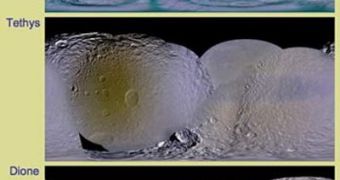Recent images of some of Saturn's moons have revealed strange patches of color on the surface of the five innermost natural satellites, Mimas, Enceladus, Tethys, Dione, and Rhea. Some of the unusual patterns have been seen before during previous flights, but others are totally new, the investigators for the mission report. The new observations could hint at the fact that there are some yet undiscovered interactions at work between the moons and the particles orbiting the gas giant, Space reports.
Speaking recently at a meeting of the American Astronomical Society, Lunar and Planetary Institute expert Paul Schenk, from Houston, reveals that the maps which yielded the peculiarities were created by combining photos sent back by the Cassini space probe, a collaboration between NASA and the European Space Agency (ESA). One of the most important things that the maps reveal is the fact that many of the moons, except for Mimas, are redder on their trailing hemispheres.
The color patches were proven to exist through a scientific process in which the so-called redness of the surface is established. In order to do this, astronomers need to divide the brightness of the surface as in infrared light with the value of the brightness obtained from ultraviolet measurements. These calculations revealed that, on the trailing side of the moons – the face that they see “forward” as moving in orbit – is redder than the opposite side. On the other face, the reddish glow is also visible, but to a lesser extent, the team that made the measurements announced.
A number of other peculiar features were discovered on the moons, such as the equatorial lens-shaped bands adorning Tethys and Mimas, hypothesized to have been caused by electrons hitting the natural satellites, as well as a discrete ultraviolet-bright feature on Rhea's equator. Future, high-resolution maps of the moons could allow Cassini operators and the international scientific community to get a better understanding of these peculiar features, as well as of the reason why the glowish patch of color exists on these bodies.

 14 DAY TRIAL //
14 DAY TRIAL //